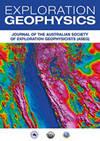伊拉克美索不达米亚盆地时间-深度转换的交叉验证和不同方法的评价
IF 0.8
4区 地球科学
Q4 GEOCHEMISTRY & GEOPHYSICS
引用次数: 1
摘要
时间-深度转换过程是地震解释中的一项重要任务,目的是在井场/远离井场的时域地球物理信息和深度域地质信息之间建立联系。如果这些模型的精度未知,那么选择合适的速度模型进行时间-深度转换以生成准确的深度图是困难的。在目前的研究中,交叉验证技术被用作一种工具,用于诊断和评估在井控处/远离井控处的时间-深度转换性能,以使用东巴格达油田的数据集预测Top Hartha和Zubair油藏的深度。为了测试这项技术,应用了四种常用的速度模型方法,用于不同速度参数场景(初始速度V0和深度梯度(K))的时间-深度转换,以生成十个速度模型(1-10)。根据速度随深度的梯度变化,检查镜头分析,速度模型(1-10)包括三个关键速度层饼:第1层(中新世-上白垩纪)、第2层(上白垩纪)和第3层(下白垩纪),从中新世中期到下白垩纪共18层。交叉验证分析表明,具有可变表面初始速度和恒定深度梯度的速度模型(模型9)是最准确的,实际深度和预测深度之间的误差较小。因此,该模型被用于构建Hartha和Zubair储层的深度图。最后,本研究提出了一个可应用于任何地质环境的区域的工作流程,以调查时间-深度转换的不确定性。本文章由计算机程序翻译,如有差异,请以英文原文为准。
Cross-validation of time-depth conversion and evaluation of different approaches in the Mesopotamian Basin, Iraq
The time-depth conversion process is a significant task in seismic interpretation to establish the link between geophysical information in the time domain and geological information in the depth domain at/away from well locations. Selecting the suitable velocity model for time-depth conversion to generate an accurate depth map is difficult if the accuracy of these models is unknown. In the current study, the cross-validation technique is used as a tool to diagnose and evaluate the performance of time-depth conversion at/away from well controls to predict the depth of Top Hartha and Zubair reservoirs using the dataset of East Baghdad Oil Field. To test this technique, four common velocity model approaches used for time-depth conversion with different scenarios of velocity parameters (initial velocity V 0 and depth gradient (K)) were applied to produce ten velocity models (1–10). According to the gradient variation of velocity with depth, check shot analysis, the velocity models (1–10) include three key velocities layer-cakes: Layer 1 (Middle Miocene-Upper Cretaceous), Layer 2 (Upper Cretaceous), and Layer 3 (Lower Cretaceous) with 18 horizons from Middle Miocene down to Lower Cretaceous. The cross-validation analysis reveals that the velocity model with a variable surface initial velocity and constant depth gradient (Model 9) was the most accurate with fewer mistie between actual and predicted depth. Consequently, this model is used to construct the depth map of the Hartha and Zubair reservoirs. Finally, this study progresses a workflow that can be applied to the region with any geological setting to investigate time-depth conversion uncertainty.
求助全文
通过发布文献求助,成功后即可免费获取论文全文。
去求助
来源期刊

Exploration Geophysics
地学-地球化学与地球物理
CiteScore
2.30
自引率
0.00%
发文量
33
审稿时长
>12 weeks
期刊介绍:
Exploration Geophysics is published on behalf of the Australian Society of Exploration Geophysicists (ASEG), Society of Exploration Geophysics of Japan (SEGJ), and Korean Society of Earth and Exploration Geophysicists (KSEG).
The journal presents significant case histories, advances in data interpretation, and theoretical developments resulting from original research in exploration and applied geophysics. Papers that may have implications for field practice in Australia, even if they report work from other continents, will be welcome. ´Exploration and applied geophysics´ will be interpreted broadly by the editors, so that geotechnical and environmental studies are by no means precluded.
Papers are expected to be of a high standard. Exploration Geophysics uses an international pool of reviewers drawn from industry and academic authorities as selected by the editorial panel.
The journal provides a common meeting ground for geophysicists active in either field studies or basic research.
 求助内容:
求助内容: 应助结果提醒方式:
应助结果提醒方式:


